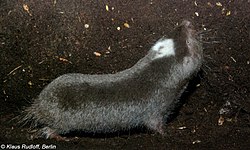| Common name | Scientific name and subspecies | Range | Size and ecology | IUCN status and estimated population |
|---|
| Ansell's mole-rat  | F. anselli
(Burda, Zima, Scharff, Macholán, & Kawalika, 1999) | Zambia | Size: 10–14 cm (4–6 in) long, plus 1–3 cm (0.4–1.2 in) tail [13]
Habitat: Savanna [14]
Diet: Roots, bulbs, tubers, and aloe leaves, as well as earthworms and insects [9] | LC
Unknown  [14] [14]
|
|---|
| Bocage's mole-rat
| F. bocagei
(De Winton, 1897) | Southwestern Africa | Size: 14–17 cm (6–7 in) long, plus 0.5–2 cm (0.2–0.8 in) tail [13]
Habitat: Savanna, shrubland, and grassland [15]
Diet: Roots, bulbs, tubers, and aloe leaves, as well as earthworms and insects [9] | LC
Unknown  [15] [15]
|
|---|
| Caroline's mole-rat
| F. vandewoestijneae
Van Daele, Blondé, Stjernstedt, & Adriaens, 2013 | South-central Africa | Size: 8–15 cm (3–6 in) long, plus 1–3 cm (0.4–1.2 in) tail [13]
Habitat: Forest and grassland [16]
Diet: Roots, bulbs, tubers, and aloe leaves, as well as earthworms and insects [9] | DD
Unknown  [16] [16]
|
|---|
| Damaraland mole-rat  | F. damarensis
(Ogilby, 1838) | Southern Africa | Size: 15–18 cm (6–7 in) long, plus 2–3 cm (1 in) tail [13]
Habitat: Shrubland and grassland [17]
Diet: Roots, bulbs, tubers, and aloe leaves, as well as earthworms and insects [9] | LC
Unknown  [17] [17]
|
|---|
| Ghana mole-rat
| F. zechi
Matschie, 1900 | Ghana | Size: 12–23 cm (5–9 in) long, plus about 2 cm (1 in) tail [13]
Habitat: Savanna, shrubland, and grassland [18]
Diet: Roots, bulbs, tubers, and aloe leaves, as well as earthworms and insects [9] | LC
Unknown  [18] [18]
|
|---|
| Hanang mole-rat  | F. hanangensis
Faulkes, Mgode, Archer, & Bennett, 2017 | Tanzania | Size: About 11 cm (4 in) long, plus about 1 cm (0 in) tail [13]
Habitat: Grassland [19]
Diet: Roots, bulbs, tubers, and aloe leaves, as well as earthworms and insects [9] | EN
100–200  [19] [19]
|
|---|
| Kafue mole-rat
| F. kafuensis
(Burda, Zima, Scharff, Macholán, & Kawalika, 1999) | Zambia | Size: 9–13 cm (4–5 in) long, plus 1–2 cm (0–1 in) tail [13]
Habitat: Savanna [20]
Diet: Roots, bulbs, tubers, and aloe leaves, as well as earthworms and insects [9] | VU
Unknown  [20] [20]
|
|---|
| Livingstone's mole-rat
| F. livingstoni
Faulkes, Mgode, Archer, & Bennett, 2017 | Tanzania | Size: About 12 cm (5 in) long, plus about 1 cm (0.4 in) tail [13]
Habitat: Unknown [21]
Diet: Roots, bulbs, tubers, and aloe leaves, as well as earthworms and insects [9] | DD
Unknown  [21] [21]
|
|---|
| Mashona mole-rat  | F. darlingi
(Thomas, 1895) | Zimbabwe and Mozambique | Size: 12–17 cm (5–7 in) long, plus 0.5–2 cm (0.2–0.8 in) tail [13]
Habitat: Shrubland and grassland [22]
Diet: Roots, bulbs, tubers, and aloe leaves, as well as earthworms and insects [9] | LC
Unknown  [22] [22]
|
|---|
| Mechow's mole-rat  | F. mechowi
(Peters, 1881)
- F. m. mechowi
- F. m. mellandi
| South-central Africa | Size: 13–26 cm (5–10 in) long, plus 2–4 cm (1–2 in) tail [13]
Habitat: Savanna, shrubland, and grassland [23]
Diet: Roots, bulbs, tubers, and aloe leaves, as well as earthworms and insects [9] | LC
Unknown  [23] [23]
|
|---|
| Nigerian mole-rat
| F. foxi
(Thomas, 1911) | Nigeria and Cameroon | Size: 16–20 cm (6–8 in) long, plus 1–3 cm (0.4–1.2 in) tail [13]
Habitat: Grassland [24]
Diet: Roots, bulbs, tubers, and aloe leaves, as well as earthworms and insects [9] | DD
Unknown  [24] [24]
|
|---|
| Ochre mole-rat
| F. ochraceocinereus
(Heuglin, 1864)
- F. o. ochraceocinereus
- F. o. oweni
| Central Africa | Size: 15–20 cm (6–8 in) long, plus 1–3 cm (0.4–1.2 in) tail [13]
Habitat: Savanna, shrubland, and grassland [25]
Diet: Roots, bulbs, tubers, and aloe leaves, as well as earthworms and insects [9] | LC
Unknown  [25] [25]
|
|---|
| Somali striped mole-rat
| F. ilariae
Gippoliti & Amori, 2011 | Somalia | Size: About 12 cm (5 in) long, plus tail [13]
Habitat: Shrubland [26]
Diet: Roots, bulbs, tubers, and aloe leaves, as well as earthworms and insects [9] | DD
Unknown  [26] [26]
|
|---|










